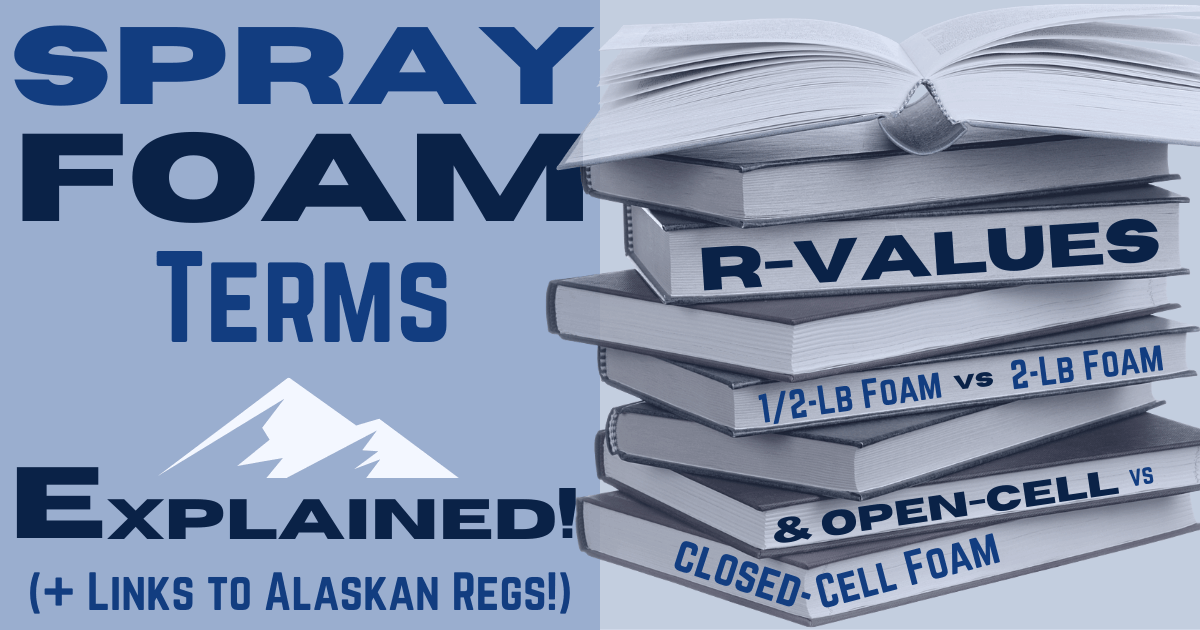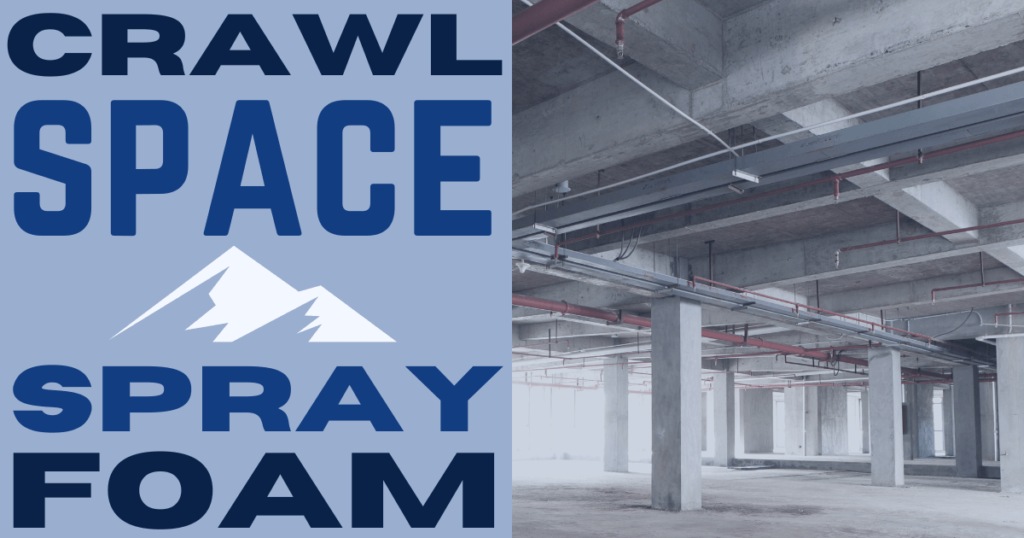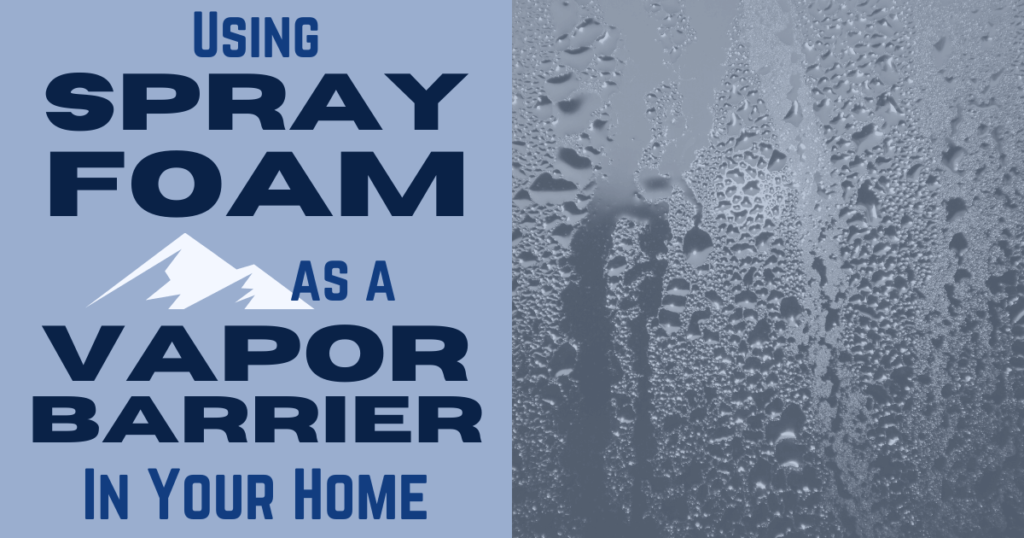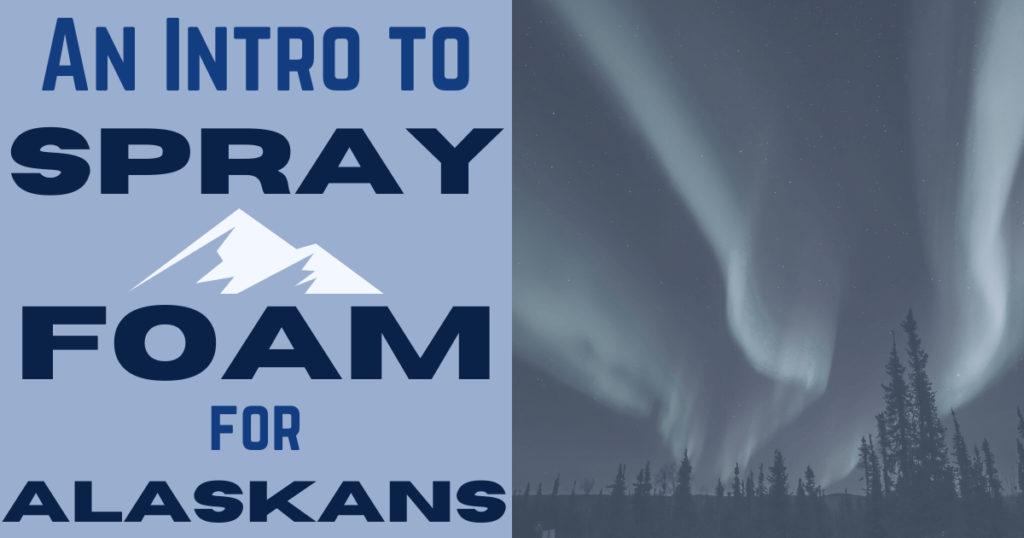Spray Foam Insulation Terms Explained
Understanding R-Values, Comparing Open- and Closed-Cell Spray Foam, and Introducing Alaskan Energy Regulations
Are you thinking about installing spray foam insulation in your home but having a difficult time deciphering all of the industry lingo?
All the information you need should be stated in plain English – we agree! Xtreme Alaska Spray Foam is all about clear communication.
That’s why we’re going to demystify all that crazy jargon.
We want to make spray foam as approachable as possible so that you can make the best insulation decisions for your family!
To do that, we’ll examine why people use insulation, discuss R-Values, explore the differences between open- and closed-cell foam, and take a look at the Alaskan energy guidelines.
Let’s go!
Why Do We Use Insulation?
Our houses have come a long way from the caves and hovels we claimed as shelter back in the dawn of our species.
We have heating and air conditioning, for goodness sake – not to even mention indoor plumbing.
Unlike when we used campfires in those old-school caves, our modern-day houses don’t need to let that heated air (and money) escape into the wild night.
We’ve learned how to better control our energy loss.
But even with novel inventions like doors, nature desperately strives to obtain a state of equilibrium.
Science dictates that heat will dissipate into the less-heated areas surrounding it until all of that precious coziness is distributed evenly…
…Like sharing a single chocolate chip cookie with an entire kindergarten class.
Nope, you’re right. There’s not gonna be much heat (or cookie) left over for your cave…umm…house…
Unless something is in place to contain that heat we produce for our homes…before it’s just a mass of forgotten crumbs. (RIP, chocolate chip cookie.)
That’s why we install insulation!
Insulation acts as a barrier between the lived-in areas of our homes and the outside world. It creates a container, of sorts, for the air we condition to our liking and drastically cuts down on the amount of energy lost through our walls, ceilings, and floors.
(And nothing does that better than spray foam insulation!… But we’ll get to that…)
Because this incredible planet we live on has different climate zones, the type and thickness of insulation necessary to keep our homes warm in the winter and cool in the summer varies based on where you live in the world.
As such, building regulations differ based on where you live, too.
Alaskans understand unique climates better than most!
We have glorious winters in our state…but they might prove to be more than a home built in, say, Arizona can withstand.
That’s why each state – and sometimes counties and boroughs – create building regulations specific to their region.
Let’s take a brief look at the energy guidelines for Alaska.
Alaskan Energy Guidelines
The energy guidelines for the state of Alaska, put forth by the International Code Council and the Alaska Housing Finance Corporation (AHFC), are called the Building Energy Efficiency Standards – or the “Alaskan BEES.”
As of April 2022, the BEES are made up of the 2018 International Energy Conservation Code (IECC) and a set of amendments specific to Alaskans’ needs.
Alaska is so big – and the climates so varied – that the requirements for insulation use differ widely across the state. You’ll need to contact your borough and city for regional-specific regulations, but the BEES should be enough to get you started with your insulation research!
Insulation in our homes needs to produce a specific “R-Value” based on the guidelines for your particular region.
What are R-Values? We’re glad you asked!
What are R-Values?
R-Values measure the resistance of a substance to energy transfer across or through it.
Insulation – the barrier we use to block energy flow through our house walls, floors, and ceilings – is required to display a certain R-Value by our state and local governments.
Different materials produce different R-Values, based on their composition and density.
Generally speaking, the thicker and denser the material, the higher the R-Value it will display.
The requirements for R-Values in any given structure are based on the environmental conditions of your region. Those required for buildings in Alaska, therefore, will not be the same as those necessary in Kansas or Florida or Arizona.
A range of materials are used for insulation, and they all display different R-Values. All insulation materials are better choices than nothing, and each type has its place…
But nothing reduces energy loss and saves you money on your energy bills like spray foam insulation!
What Makes Spray Foam Insulation Great?
Spray foam is king in the insulation industry!
What makes it so great?
Well.
Spray foam insulation has excellent R-Value capabilities AND displays its true R-Value throughout its lifetime!
As we discussed in our blog post introducing spray foam, other types of insulation (like blown-in cellulose and fiberglass batts) are often subject to settling in walls, which reduces the insulation capabilities of those materials and can lead to much lower R-Values in practice than in theory.
Wall settling can also lead to high energy losses in your home.
(Thanks, gravity.)
Spray foam insulation, however, is sprayed directly onto the wall (or another receiving surface) and stays there. No wall settling for spray foam!
That means that the stellar R-Values that spray foam is formulated to produce are the true R-Values displayed in your home…forever!
And that’s a big deal! That saves you money!
But wait! It gets better.
Spray foam insulation creates a completely air-tight seal between the inside and outside of your home.
That’s right! No air can cross the spray foam insulation barrier, which drastically reduces the energy transfer in your home – AND cuts down on the energy you need to pump into your living space to keep it cozy!
Installing spray foam insulation is like wrapping an impenetrable blanket around your house…which is sorta the point of insulation, right?
No more sharing your heat with the bears and moose outside. (Sorry, guys!)
What’s the best type of spray foam insulation for your needs?
Let’s take a look!
What are the Differences Between Open- and Closed-Cell Foam?
Spray foam insulation is available in two main types: open-cell and closed-cell.
Open-cell foam is soft and pliable, like a kitchen sponge. It creates a network of open – or connected – “cells,” which fill with air to form an insulating barrier.
This type of foam relies on its connected cell structure to produce its ideal R-Value, so it needs adequate space to expand when applied.
Since wall cavities are only so big, and open-cell R-Values are ~R4 per inch, open-cell foam is best suited to mild climates or odd jobs with excess space available.
If, in the course of your spray foam insulation research, you hear the term “1/2-pound foam,” it refers to open-cell foam. Typically, one square foot of open-cell foam weighs around 1/2 of a pound. There are exceptions to this rule, but that is the source of the term.
“2-pound foam,” on the other hand, refers to closed-cell foam. One square foot of closed-cell foam tends to weigh about two pounds (again, with some exceptions).
Closed-cell foam is typically a dense, rigid foam formed of a matrix of individual, closed-off cells. These separate cavities don’t allow anything to pass through them after curing.
Even moisture.
That’s right! Both open- and closed-cell foams produce an air-tight seal within a building – but closed-cell foam can also act as a moisture barrier for your home.
Closed-cell foam displays R-Values of ~R7/inch, and the dense nature of this type of foam makes it ideal for use in tight spaces and cold environments (like Alaska!).
Both open- and closed-cell spray foam are superb insulators, but the space required to reach the same R-Values differs.
If the regulations for your area call for insulation that displays an R-Value of 25, for instance, you’d need ~6.5” of open-cell foam vs. ~4” of closed-cell foam to meet requirements.
If you have any questions about which foam to use for your insulation project, give Xtreme Alaska Spray Foam a call!
We are here to help, and always enjoy talking to you.
Conclusion
No two spray foam jobs are exactly the same.
For instance, instead of your house, maybe you want to insulate your toy trailer or your chicken barn.
Those buildings all serve different functions and, therefore, have different insulation needs…
But spray foam is an excellent insulator, no matter where you use it!
And wherever you need it, Xtreme Alaska Spray Foam can spray it for you.
Your peace of mind always matters to us.
If you have any questions about which spray foam to use – or you just feel like you need help understanding all of this jargon – don’t hesitate to reach out!
We want to answer your spray foam insulation questions once and for all so you can sleep better (and cozier) at night.
We look forward to talking with you!








2 Comments
Comments are closed.